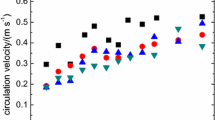Summary
Alcaligenes sp. A 7-2 has been applied in a packed-bed fermenter to degrade 4-chlorophenol in municipal wastewater continuously. With sterile wastewater degradation rates up to 300 μmol/l/h were reached when precultivated Alcaligenes sp. A 7-2 had been adsorbed onto the Lecaton-packed-bed-material.
The natural microbial population of the wastewater was not able to degrade 4-chlorophenol. Beside an accumulation of the haloaromatic compound a yellow-greenish substance exhibiting the spectral characteristics of 5-chloro-2-hydroxymuconic acid semialdehyde was found.
This compound caused a rapid decrease in metabolic activity of the microbial culture.
With non-sterile wastewater Alcaligenes sp. A 7-2 could not be established as member of the natural mixed population. Due to the poor retainment of the specialized strain in the packed-bed the degradation capacity of the fermentation system decreased and 4-chlorophenol was accumulated.
Similar content being viewed by others
References
Bartels I, Knackmuss H-J, Reineke W (1984) Suicide inactivation of catechol 2,3-dioxygenase from Pseudomonas putida mt-2 by halocatechols. Appl Environ Microbiol 47:500–505
Bettmann H, Rehm H-J (1985) Continuous degradation of phenol(s) by Pseudomonas putida P8 entrapped in polyacrylamidehydrazide. Appl Microbiol Biotechnol 22:389–393
Dorn E, Hellwig M, Reineke W, Knackmuss H-J (1974) Isolation and characterization of a 3-chlorobenzoate degrading Pseudomonad. Arch Microbiol 99:61–70
Dorn E, Knackmuss H-J (1978a) Chemical structure and biodegradability of halogenated aromatic compounds. Two catechol 1,2-dioxygenases from a 3-chlorobenzoate-grown Pseudomonad. Biochem J 174:73–84
Dorn E, Knackmuss H-J (1978b) Chemical structure and biodegradability of halogenated aromatic compounds. Substituent effects on 1,2-dioxygenation of catechol. Biochem J 174:85–94
Grishchenkov VG, Fedechkina IE, Baskunov BP, Anisimova LA, Boronin AM, Golovleva LA (1984) Degradation of 3-chlorobenzoic acid by a Pseudomonas putida strain. Microbiology 52:602–606
Hartmann J, Reineke W, Knackmuss H-J (1979) Metabolism of 3-chloro-, 4-chloro-, and 3,5-dichlorobenzoate by a Pseudomonad. Appl Environ Microbiol 37:421–428
Klages U, Markus A, Lingens F (1981) Degradation of 4-chlorophenylacetic acid by a Pseudomonas species. J Bacteriol 146:64–68
Knackmuss H-J (1979) Halogenierte und sulfonierte Aromaten — Eine Herausforderung für Aromaten abbauende Bakterien. Forum Mikrobiologie 6:311–317
Martin RW (1949) Rapid colorimetric estimation of phenol. Anal Chem 21:1419
Pfennig N, Lippert KD (1966) Über das Vitamin B12-Bedürfnis phototropher Schwefelbakterien. Arch Microbiol 55:245–256
Reineke W, Knackmuss H-J (1984) Microbial metabolism of haloaromatics: isolation and properties of a chlorobenzen-degrading bacterium. Appl Environ Microbiol 47:395–402
Sala-Trepat JM, Evans WC (1971) The meta-cleavage of catechol by Azotobacter species. 4-Oxocrotonate pathway. Eur J Biochem 20:400
Schmidt E, Knackmuss H-J (1980) Chemical structure and biodegradability of halogenated aromatic compounds. Biochem J 192:339–347
Schmidt E, Hellwig M, Knackmuss H-J (1983) Degradation of chlorophenols by a defined mixed microbial community. Appl Environ Microbiol 46:1038–1044
Schwien U, Schmidt E (1982) Improved degradation of monochlorophenols by a constructed strain. Appl Environ Microbiol 44:33–39
van den Berg L, Lentz CP, Armstrong DW (1980) Methane production rates of anaerobic fixed film fermentors as compared to those of anaerobic contact and fully mixed continuous fermentors. Advances in Biotechnology Vol II. Proc 6th Int Ferm Symp London, Canada
Westmeier F, Rehm H-J (1985) Biodegradation of 4-chlorophenol by entrapped Alcaligenes sp. A 7-2. Appl Microbiol Biotechnol 22:301–305
Westmeier F, Rehm H-J (1986) Einsatz von Immobilisations-verfahren zum biologischen Abbau chlorierter Phenole. Chem Ind 38:158–160
Author information
Authors and Affiliations
Rights and permissions
About this article
Cite this article
Westmeier, F., Rehm, H.J. Degradation of 4-chlorophenol in municipal wastewater by adsorptiv immobilized Alcaligenes sp. A 7-2. Appl Microbiol Biotechnol 26, 78–83 (1987). https://doi.org/10.1007/BF00282152
Received:
Accepted:
Issue Date:
DOI: https://doi.org/10.1007/BF00282152




